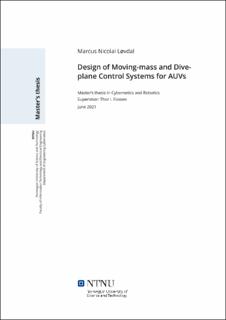| dc.contributor.advisor | Fossen, Thor I. | |
| dc.contributor.author | Løvdal, Marcus Nicolai | |
| dc.date.accessioned | 2021-09-23T19:05:08Z | |
| dc.date.available | 2021-09-23T19:05:08Z | |
| dc.date.issued | 2021 | |
| dc.identifier | no.ntnu:inspera:76427839:50740253 | |
| dc.identifier.uri | https://hdl.handle.net/11250/2781107 | |
| dc.description.abstract | I denne oppgaven er litteratursøk om «moving-mass» aktuering and kontroll for fartøy i forskjellige bruksområder gjennomført, inkludert forskjellige konfigurasjoner av aktueringen. Fordeler og ulemper med å implementere «moving-mass» aktuering (MMA) i autonome undervannsfartøy (AUV) er vurdert og sammenlignet mot bruk av dybderor, både i teori og i simuleringer. Bevegelsesligningene for det koblede MMA-AUV-systemet er utledet basert på bevaring av bevegelsesmengde og modifisert til å inkludere dybderor, miljø-, demping- og tyngdekrefter for fartøy med oppdrift. Kontrollover for MMA og dybderor er utledet for stigningvinkel og dybde, verifisert og sammenlignet. Fartøyet er simulert med hensyn til forskjellige kombinasjoner aktuatorene og resultatene er sammenlignet. Case-studier av å implementere MMA for å gjennomføre spesifikke funksjoner er gjennomført og diskutert. | |
| dc.description.abstract | In this thesis, the literature on moving-mass actuation and control for vehicles in various applications is reviewed and discussed, considering a variety of moving-mass configurations. The advantages and disadvantages of implementing moving-mass actuation (MMA) in autonomous underwater vehicles (AUVs) are considered and compared to traditional dive-plane (DP) actuation, both in theory and in simulations. The equations of motion for the coupled MMA-AUV system are derived based on conservation of momentum and modified to include dive-planes, environmental, damping, and restoring forces for buoyant vehicles. Control laws for MMA and dive-planes are derived for pitch and depth control, verified in simulations and compared. The vehicle is simulated considering combinations of actuation methods and the results are compared. Case studies for implementing MMA as a failsafe function, as a drag reduction method, and as an auxiliary actuator are simulated and discussed. | |
| dc.language | eng | |
| dc.publisher | NTNU | |
| dc.title | Design of Moving-mass and Dive-plane Control Systems for AUVs | |
| dc.type | Master thesis | |
